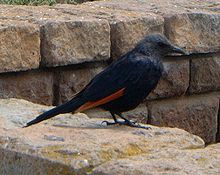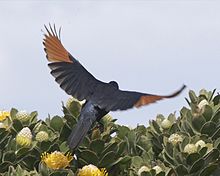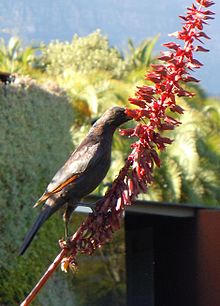- Red-winged Starling
-
Red-winged Starling 
Female Red-winged Starling Conservation status Scientific classification Kingdom: Animalia Phylum: Chordata Class: Aves Order: Passeriformes Family: Sturnidae Genus: Onychognathus Species: O. morio Binomial name Onychognathus morio
(Linnaeus, 1766)The Red-winged Starling, Onychognathus morio, is a bird of the starling family Sturnidae native to eastern Africa from Ethiopia to the Cape in South Africa. It is known in Afrikaans as the Rooivlerkspreeu.
Contents
Taxonomy
The Red-winged Starling was first described by Linnaeus in 1766. Two subspecies are recognised.
 Chestnut-coloured primaries, which are particularly noticeable in flight, help to distinguish this species from the similar Pale-winged Starling.
Chestnut-coloured primaries, which are particularly noticeable in flight, help to distinguish this species from the similar Pale-winged Starling.
Description
The male of this 27–30 cm (11–12 in) long starling has mainly iridescent black plumage, with chestnut flight feathers, which are particularly noticeable in flight. The female has an ash-grey head and upper breast. The juvenile resembles the male, but is less glossy than the adults, and has brown rather than dark red eyes. The Ethiopian subspecies O. m. rupellii is longer-tailed than the nominate form and intergrades with it.
This species has a number of whistled calls, but the most familiar is the contact call, cher-leeeoo.
This starling may be confused with other similar starling species, such as its sister species the Pale-winged Starling. The difference between the two is that the Red-winged has rufous primaries while the Pale-winged has whitish primaries edged with orange. The Pale-winged has a bright red or orange eye, while the Red-winged's is dark, almost black[1]. Only the female of the Red-winged has a grey head.
Distribution and habitat
The range is down eastern Africa from Ethiopia to the Cape in South Africa. This species has a wide habitat tolerance. It may be found in forest, savanna, grassland, wetlands, fynbos, farmlands and commercial plantations, as well as urban centres. It is now common in many urban areas, due to the similarity between the structure of tall buildings and houses as nest sites with the cliffs of its original habitat. It may also nest in residential areas, breeding in roofs and apertures and up house eaves.
Behaviour
Food and feeding
 A male Red-winged Starling feeding on a Melianthus inflorescence
A male Red-winged Starling feeding on a Melianthus inflorescence
Like other starlings, the Red-winged Starling is an omnivore, taking a wide range of seeds, berries, nectar from plants such as Aloe and Schotia brachypetala, and invertebrates, such as the beetle species Pachnoda sinuata. They may take nestlings and adults of certain bird species, such as the African Palm Swift.[2] It will also scavenge on carrion and human food scrap.
The Red-winged Starling will obviously only perch on plant structures that will be able to support its weight; therefore when taking nectar it will choose certain species with strong, robust racemes with easily accessible flowers, such as that of Aloe ferox and Aloe marlothii, and not Aloe arborescens. Large flowers that can support the bird's weight, such as that of Strelitzia nicolai and certain Protea species, are also chosen.
Fruit species that this species may feed on include figs, such as the Sycamore Fig and others, marulas, date palm fruit, berries from species such as wild olive Olea europaea spp. africana and Euphorbia, and commercial fruit such as apples, grapes, citrus fruit and others.
In rural areas, Red-winged Starlings are often spotted perching on livestock and game, such as cattle, klipspringers and giraffes, a trait shared by the Pale-winged Starling[3], and may take insects and ectoparasites such as ticks, much in the manner of oxpeckers.
Breeding
The Red-winged Starling is territorial, aggressive and intolerant when nesting, and will attack other species, including domestic animals and humans. When not breeding, Red-winged Starlings are highly gregarious and will associate with other members of their species in large flocks.
This starling is a cliff nester, breeding on rocky cliffs, outcrops and gorges. The Red-winged Starling builds a lined nest of grass and twigs, and with a mud base, on a natural or structural ledge. It lays 2–4, usually three, blue eggs, spotted with red-brown. The female incubates the eggs for 13–14 days, with another 22–28 days to hatching. This starling is commonly double-brooded. It may be parasitised by the Great Spotted Cuckoo.
Predators
It is preyed upon by other birds such as Peregrine Falcons, Pied Crows, and Gymnogene.[4]
Status
The Redwinged Starling is not endangered and it can be a pest in some areas, raiding orchards and attacking people that wander too close to their nests.
References
- ^ http://books.google.co.za/books?id=yYqLZtf5w0gC&dq=red-winged+starling+roberts+guide&q=red-winged+starling#v=snippet&q=red-winged%20starling&f=false
- ^ http://www.biodiversityexplorer.org/birds/sturnidae/onychognathus_morio.htm
- ^ http://web.uct.ac.za/depts/stats/adu/pdf/bn12_1p20-30.pdf
- ^ http://www.biodiversityexplorer.org/birds/sturnidae/onychognathus_morio.htm
- Feare, Chris; Craig, Adrian (1999). Starlings and Mynas. Princeton University Press. ISBN 0-7136-3961-X.
- Sinclair, Hockey and Tarboton, SASOL Birds of Southern Africa, ISBN 1-86872-721-1
External links
Categories:- IUCN Red List least concern species
- Sturnidae
- Birds of South Africa
- Animals described in 1766
Wikimedia Foundation. 2010.

